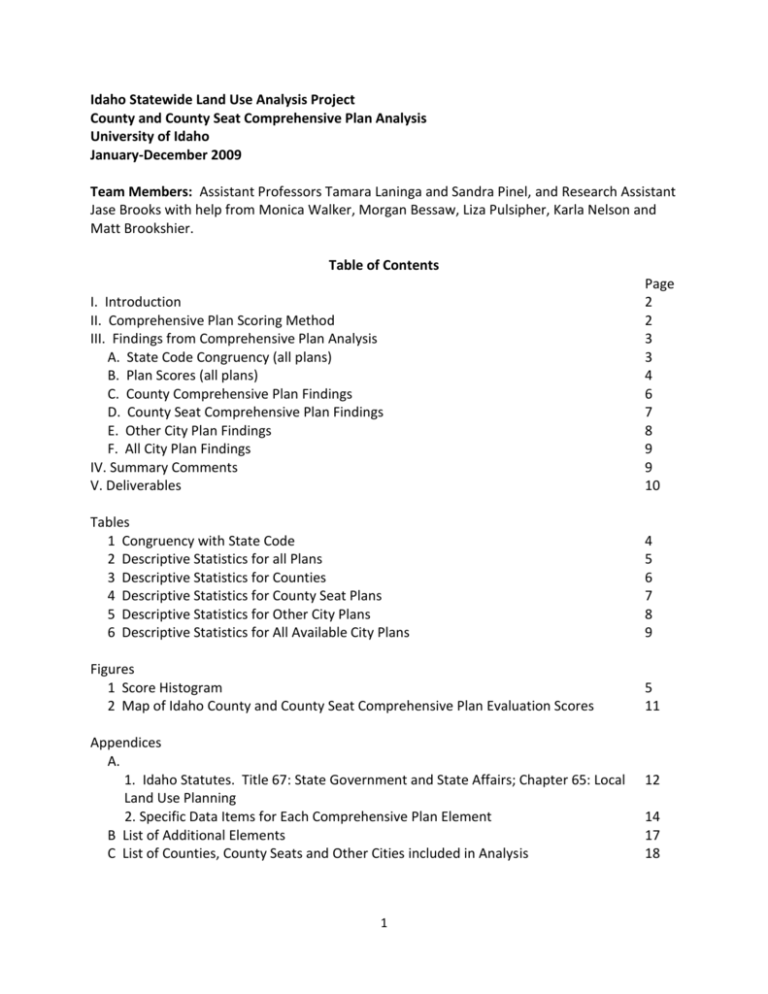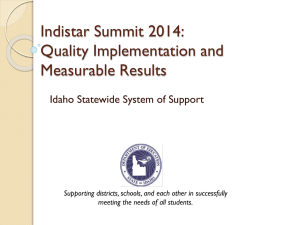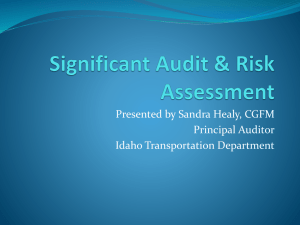Idaho Statewide Land Use Analysis Project
advertisement

Idaho Statewide Land Use Analysis Project
County and County Seat Comprehensive Plan Analysis
University of Idaho
January-December 2009
Team Members: Assistant Professors Tamara Laninga and Sandra Pinel, and Research Assistant
Jase Brooks with help from Monica Walker, Morgan Bessaw, Liza Pulsipher, Karla Nelson and
Matt Brookshier.
Table of Contents
I. Introduction
II. Comprehensive Plan Scoring Method
III. Findings from Comprehensive Plan Analysis
A. State Code Congruency (all plans)
B. Plan Scores (all plans)
C. County Comprehensive Plan Findings
D. County Seat Comprehensive Plan Findings
E. Other City Plan Findings
F. All City Plan Findings
IV. Summary Comments
V. Deliverables
Page
2
2
3
3
4
6
7
8
9
9
10
Tables
1 Congruency with State Code
2 Descriptive Statistics for all Plans
3 Descriptive Statistics for Counties
4 Descriptive Statistics for County Seat Plans
5 Descriptive Statistics for Other City Plans
6 Descriptive Statistics for All Available City Plans
4
5
6
7
8
9
Figures
1 Score Histogram
2 Map of Idaho County and County Seat Comprehensive Plan Evaluation Scores
5
11
Appendices
A.
1. Idaho Statutes. Title 67: State Government and State Affairs; Chapter 65: Local
Land Use Planning
2. Specific Data Items for Each Comprehensive Plan Element
B List of Additional Elements
C List of Counties, County Seats and Other Cities included in Analysis
1
12
14
17
18
I. Introduction to the comprehensive plan analysis
The Idaho Local Land Use Planning Act was passed in 1975. Idaho is now the 6 th fastest growing
state in the country. Idaho Code requires cities and counties to have comprehensive plans (a
written vision for their community) and land use zoning ordinances. Unlike some of its
neighboring states, Idaho does not have a statewide land use agency or any state-based
funding for cities and counties to carry out their land use planning work. Furthermore, many
Idaho cities and counties have limited or nonexistent budgets for planning staff- in some cases,
city clerks, city treasurers, and city engineers serve that role. Because of these limitations,
many communities are using comprehensive plans and zoning ordinances that were put in
place when the state law was enacted in 1975.
Idaho Smart growth convened a steering committee including teams from the University of
Idaho and Boise State University to complete a comprehensive analysis of Idaho’s laws, state,
county, and city policies, rules and permitting provisions to examine the extent to which Idaho
county and city comprehensive plans are meeting the goals and requirements of the Idaho
Local Land Use Planning Act. To undertake this task comprehensive plans for all county and
county seats, as well as a number of other large cities were analyzed for congruence with state
enabling planning and land use statues, a survey was completed, and focus groups where held
around the state.
The information that follows provides a review of the analysis from the comprehensive plan
analysis conducted by the University of Idaho team.
II. Comprehensive Plan Scoring Method
A total of 40 out of 44 Idaho county comprehensive plans were collected; 30 out of 44 county
seat plans were collected; and 31 other city plans were collected.1 These “other cities” often
include the largest city in a county, especially if it was not the county seat. Plans were collected
from county and city websites and direct request.
Each collected plan was reviewed for congruency with the Idaho Local Land Use Act’s thirteen
required elements, outlined in Title 67, Chapter 65 §67-6508. A document called Smart Towns:
A Guide to Growth Management for Idaho City and County Officials available from the
Association of Idaho Cities expounds on the specific data requirements for each of the thirteen
1
The following county plans are missing: Jerome, Clark, and Butte. Idaho County does not have a plan. The
following county seat plans are missing: American Falls (Power), Bonners Ferry (Boundary), Burley (Cassia),
Councils (Adams), Fairfield (Camas), Gooding (Gooding), Idaho City (Boise), Murphy (Owyhee), Paris (Bear Lake),
Shoshone (Lincoln), St. Maries (Benewah), Weiser (Washington), Dubois (Clark). Nezperce (Lewis) does not have a
plan.
2
elements and presents a user-friendly interpretation of data needs for each element. To score
the plans, a rubric for each element was created using the suggested interpretations of the
Local Land Use Planning Act requirements as described in the 2007 Smart Towns guide
distributed by the Association of Idaho Cities, which is an organization of Idaho municipalities
that works to increase the capacity of cities to practice effective governance. The document is
well aligned with the state code, but does include some items that are not explicitly required as
stated in the statues. The Idaho Local Land Use Planning Act statute and the Smart Towns list
of element topics are included in Appendix A.
The bold items in the Smart Towns list are explicitly asked for in the statues. The other topics
may be implicit in the statute’s request for an ‘analysis’ or are recommended by the Association
of Idaho Cities as part of a comprehensive, well-informed element. For the sake of maintaining
reliable scoring, all plans were subject to the same rubric parameters despite the planning
capacity of each jurisdiction. The final score is the sum of the number of rubric items included
in each county and city plan. The maximum score is 58 points. No plan received a perfect score
of 58. The highest county comprehensive plan was Madison County (48); the highest county
seat comprehensive plan was Jerome (47); and the highest “other city” comprehensive plan
was Meridian (49).
A number of additional elements were also considered during the comprehensive plan analysis.
These elements came from previous studies that have looked at comprehensive plans. The list
of additional elements that may have been included in a comprehensive plan are listed in
Appendix B.
III. Findings from Comprehensive Plan Analysis
This section provides descriptive statistics for the county, county seat and other city
comprehensive plans that were analyzed for this project. Appendix C lists all the counties,
county seats and other cities included in the analysis along with their plan score.
A. State Code Congruency (all plans)
Overall plan congruency with state statutes, when considering the specific data items listed in
the Smart Town guide, is fairly low. Many plans only include goal and policy information with
very little data as required by state code. Some plans include data, but it is so outdated that it
would be useless for decision-making and analysis. Some plans reference additional reports
used by planning commissions to create each element. However, those plans still did not
include much of the data required by Idaho State code as described by the Smart Towns
document. Table 1 shows congruency with the state code rubric for each element, based on
how well each plan incorporates specific data items as outlined in the Smart Towns guide. The
third column, “Plans Including Element,” shows the percentage of plans that include the
element in their plan. The fourth column, “Statewide Element Congruency,” shows the
percentage of all plans that included the specific data items as outline in the Smart Towns
guide.
3
To calculate the congruency with state code for each element, each plan’s element points were
divided by its total number of points possible to generate a percentage of points attained for
each plan. These were then averaged for the state. The lowest percentages from this
calculation represent the weakest congruency between state code and actual plans reviewed.
The sample of 101 plans represents only 51% congruency with state code overall.
The Property Rights element is the strongest element, but also the easiest to meet. The State
Attorney General’s Takings Checklist must be present in the plan or it must be referenced in
this element’s narrative. The weakest elements statewide are Community Design and Hazards.
The state standards for the Community Design element require information about signs,
landscape, and building design. These are usually found in city code as ordinances, which
means that they may be present, but were neglected to be included in the comprehensive plan.
It is notable that one of the weakest element congruency happens to be the element that
Idahoans may perceive as most invasive to private property rights. The Hazards element should
include information about flooding, avalanche and mudslides, irrigation ditches, railroad
crossings, and bulk fuel storage. Very few plans included information on all five topics with
most plans just including information about flooding or mudslides and avalanches.
Table 1 Congruency with State Code
Elements
Special Areas
Property Rights
Population
Implementation
Public Services
Land Use
Natural Resources
Economic Development
Housing
Recreation
Transportation
Schools/Education
Hazards
Community Design
Total
N=101
Potential
Points
1
1
5
1
9
4
4
4
3
4
10
3
5
4
58
Plans Including
Element
75%
74%
94%
72%
89%
95%
86%
82%
75%
82%
88%
76%
82%
58%
Statewide Element
Congruency
75%
70%
68%
67%
62%
59%
59%
52%
52%
46%
42%
40%
35%
32%
51%
B. Plan Scores
The mean score for all plans reviewed is 30.3, with a standard deviation of 11.74. The
distribution of score is slightly skewed to the left, with several peaks in frequency through the
range. The mode, or the score that appears most frequently, is 34. A larger sample of plans may
help to correct the distribution. The average age of comprehensive plans is about 6 years; the
median year of adoption is 2005; and the mean number of pages is 94. Table 2 shows
descriptive statistics for all plans reviewed. Figure 1 is a histogram of plan scores.
4
Table 2 Descriptive Statistics for All Plans
Community Design
Economic Development
Hazard
Housing
Implementation
Land Use
Natural Resources
Population
Property Rights
Public Services
Recreation
Schools
Special Areas
Transportation
Vision*
History*
Year
Pages
Score
N
100
100
100
100
100
100
100
100
100
100
100
100
100
100
100
100
102
101
101
Minimum
0
0
0
0
0
0
0
0
0
0
0
0
0
0
0
0
1980
7
3
Maximum
4
4
5
3
1
4
4
5
1
9
4
3
1
10
1
1
2009
520
49
Mean
1.65
2.09
1.78
1.58
.73
2.40
2.38
3.35
.75
5.64
1.86
1.21
.76
4.28
.31
.42
2002.95
93.61
30.30
Std. Deviation
1.660
1.240
1.177
1.148
.446
1.025
1.376
1.480
.435
2.859
1.271
.844
.429
2.705
.465
.496
5.476
79.860
11.739
Figure 1: Score Histogram
Most common additional or elected components are Vision (31%) and History (42%). Some
plans, but not many, also included citizen participation sections.
5
C. County Comprehensive Plan Findings
The mean score for county comprehensive plans is 30.5, with a standard deviation of 11.88. The
mean plan age of county comprehensive plans is about 6 years; the median year of adoption is
2000; the mean number of pages is 104. Seven county plans used consultant assistance (17.5%
of available plans). The following county plans are drafts as of this evaluation: Franklin,
Kootenai, Lewis, Madison, Twin Falls (12.5% of available county plans; 11.36% of all counties).
The elective element history is included in 41% of the plans and vision is included in 23%. Table
3 provides the descriptive statistics for county comprehensive plans.
Table 3 Descriptive Statistics for Counties
Community Design
Economic Develop
Hazard
Housing
Implementation
Land Use
Natural Resources
Population
Property Rights
Public Services
Recreation
Schools
Special Areas
Transportation
Vision*
History*
Year
Pages
Score
N
39
39
39
39
39
39
39
39
39
39
39
39
39
39
39
39
41
40
40
Minimum
0
0
0
0
0
0
0
0
0
0
0
0
0
0
0
0
1992
7
5
Maximum
4
4
5
3
1
4
4
5
1
9
4
3
1
8
1
1
2009
520
48
6
Mean
1.21
2.36
1.97
1.74
.77
2.21
2.67
3.49
.72
5.72
1.69
1.26
.82
3.90
.23
.41
2003.80
103.75
30.50
Std. Deviation
1.490
1.013
1.308
1.069
.427
1.174
1.325
1.520
.456
2.892
1.321
.818
.389
2.683
.427
.498
4.354
109.597
11.884
D. County Seat Comprehensive Plan Findings
The mean score for county seat comprehensive plans is 30.42, with a standard deviation of
12.08. The average age of county comprehensive plans is about 9 years; the median year of
adoption is 2003.5; the mean number of pages is 88. Five county seat plans used consultant
assistance. The median year of adoption is 2003.5. The elective element history is included in
40% of the plans and vision is included in 40%. Table 4 provides descriptive statistics for county
seat comprehensive plans.
Table 4 Descriptive Statistics for County Seats Plans
Community Design
Economic Development
Hazards
Housing
Implementation
Land Use
Natural Resources
Population
Property Rights
Public Services
Recreation
Schools
Special Areas
Transportation
Vision*
History*
Year
Pages
Score
N
30
30
30
30
30
30
30
30
30
30
30
30
30
30
30
30
31
31
31
Minimum
0
0
0
0
0
0
0
0
0
0
0
0
0
0
0
0
1980
0
0
7
Maximum
4
4
4
3
1
4
4
5
1
9
4
3
1
9
1
1
2009
250
47
Mean
2.6
2.37
1.7
1.6
0.67
2.47
1.93
3.5
0.7
5.03
2.2
1.2
0.8
4.83
0.4
0.4
2000.9
87.9
30.42
Std. Deviation
1.453
1.273
1.055
1.276
0.479
1.008
1.388
1.358
0.466
3.135
1.157
0.925
0.407
2.627
0.498
0.498
7.648
57.236
12.08
E. Other City Plan Findings (does not include county seat)
The mean score for other city comprehensive plans is 28.94, with a standard deviation of 12.58.
The average age of county comprehensive plans is about 5 years; the median year of adoption
is 2003.5; the mean number of pages is 83.2. The elective element history is included in 45% of
the plans and vision is included in 32%. Table 5 provides descriptive statistics for other city
plans.
Table 5 Descriptive Statistics for Other City Plans
Community Design
Economic Development
Hazards
Housing
Implementation
Land Use
Natural Resources
Population
Property Rights
Public Services
Recreation
Schools
Special Areas
Transportation
Vision*
History*
Year
Pages
Score
N
31
31
31
31
31
31
31
31
31
31
31
31
31
31
31
31
30
31
31
Minimum
0
0
0
0
0
1
0
0
0
0
0
0
0
0
0
0
1996
12
3
8
Maximum
4
4
4
3
1
4
4
5
1
9
4
2
1
9
1
1
2009
185
49
Mean
1.29
1.48
1.61
1.35
.74
2.58
2.45
3.03
.84
6.13
1.74
1.16
.65
4.23
.32
.45
2003.90
83.23
28.94
Std. Deviation
1.716
1.288
1.116
1.112
.445
.807
1.362
1.538
.374
2.500
1.290
.820
.486
2.801
.475
.506
3.367
48.761
12.588
F. All City Plan Findings (includes county seats)
The mean score for all city plans reviewed is 30.16, with a standard deviation of 11.74. The
average age of county comprehensive plans is about 7.51 years. The median year of adoption is
2004. Table 6 provides descriptive statistics for all available city plans.
Table 6 Descriptive Statistics for All Available City Plans
Community Design
Economic Development
Hazards
Housing
Implementation
Land Use
Natural Resources
Population
Property Rights
Public Services
Recreation
Schools
Special Areas
Transportation
Vision*
History*
Pages
Year
Score
N
61
61
61
61
61
61
61
61
61
61
61
61
61
61
61
61
61
61
61
Minimum
.00
.00
.00
.00
.00
.00
.00
.00
.00
.00
.00
.00
.00
.00
.00
.00
12.00
1980.00
3.00
Maximum
4.00
4.00
4.00
3.00
1.00
4.00
4.00
5.00
1.00
9.00
4.00
3.00
1.00
9.00
1.00
1.00
250.00
2009.00
49.00
Mean
1.9344
1.9180
1.6557
1.4754
.7049
2.5246
2.1967
3.2623
.7705
5.5902
1.9672
1.1803
.7213
4.5246
.3607
.4262
86.9672
2002.38
30.1639
Std. Deviation
1.71142
1.34530
1.07835
1.19173
.45986
.90566
1.38828
1.45947
.42401
2.85994
1.23784
.86618
.45207
2.71174
.48418
.49863
52.04260
6.08321
11.74050
IV. Summary Comments
• The way entities interpreted ‘analysis’ is highly variable. Some included great detail and
others included only goals and policies, but referenced back office reports that were not
included in the public document. Other plans included very little analysis, but included
factual data requested in the statutes. This complicated the determination of
congruence based on code verbiage alone and required the use of a third party
document (the Smart Towns guide) to ground inter-rater reliability, which is about 95%
for this project.
• The variability of interpretation of the code suggests that research into city and county
planning capacity would be useful for a deeper interpretation of this data. Capacity is
influenced by a wide range of factors including resource availability, staff, and funding
dedication.
• Professionally created plan scores have high variability. Newer consultant-created plans
tend to receive higher scores, but this is not consistently true.
9
•
•
A “high” score is anything above 40 points; this represents plans with above 70%
congruency with Idaho code.
Many rural counties, like Lemhi and Boundary, have well informed plans with high
congruence. Urban counties or counties near urban centers round out the highest
scores list. This raises questions about what factors contribute to an entity’s capacity to
create a plan with high congruence. Preliminary regression analysis suggests a complex
model is required to uncover relationships between large numbers of variables
describing many aspects of these communities.
• Counties with scores above 40 points include: Boundary, Bonner, Lemhi,
Fremont, Madison, Jefferson, Blaine, Boise, Gem, Payette, Ada and Twin Falls.
• Countyseats with scores above 40 points include: Driggs, Emmett, Jerome,
Moscow, Mountain Home, Payette, Rexburg, and Rigby.
• Other Cities with scores above 40 points include: Fruitland, Kuna, McCall,
Meridian, Nampa and Plummer.
•
A “low” score is anything between 1 and 19 points; this represents comprehensive plans
with less than 33% congruency with state code.
• Counties with scores of 19 or below include: Bannock, Bonneville, Caribou,
Franklin, Gooding, Latah, Owyhee, Power and Shoshone.
• County seats with scores of 19 or below include: Boise, Idaho Falls, Malad City,
Salmon, and Sandpoint.
• Other cities with scores of 19 or below include: Aberdeen, Dietrich, Island Park,
Kellogg, Melba, Rathdrum, Sugar City, Ucon and Wilder.
•
Figure 2, on page 11, graphically represents the scores.
V. Deliverables
In addition to providing descriptive statistics on comprehensive plans regarding congruence
with state statutes, as well as plan age, number of pages, and consultant developed, several
other outputs were produced by the University of Idaho comprehensive plan analysis team.
One output is an on-line database with links to all county and county seat comprehensive plan,
and plans for a number of other Idaho cities. The website is:
http://www.bioregionalplanning.uidaho.edu/IdahoPlanning/default.aspx. A map has also been
developed which shows the score analysis visually. The map is shown in Figure 2.
10
Figure 2: Map of Idaho County and County Seat Comprehensive Plan Evaluation Scores
11
Appendix A:
1. Idaho Statutes
TITLE 67: STATE GOVERNMENT AND STATE AFFAIRS
CHAPTER 65: LOCAL LAND USE PLANNING2
67-6508. PLANNING DUTIES. It shall be the duty of the planning or planning and zoning
commission to conduct a comprehensive planning process designed to prepare, implement,
and review and update a comprehensive plan, hereafter referred to as the plan. The plan shall
include all land within the jurisdiction of the governing board. The plan shall consider previous
and existing conditions, trends, desirable goals and objectives, or desirable future situations for
each planning component. The plan with maps, charts, and reports shall be based on the
following components as they may apply to land use regulations and actions unless the plan
specifies reasons why a particular component is unneeded.
(a) Property Rights -- An analysis of provisions which may be necessary to insure that
land use policies, restrictions, conditions and fees do not violate private property rights,
adversely impact property values or create unnecessary technical limitations on the use of
property and analysis as prescribed under the declarations of purpose in chapter 80, title 67,
Idaho Code.
(b) Population -- A population analysis of past, present, and future trends in
population including such characteristics as total population, age, sex, and income.
(c) School Facilities and Transportation -- An analysis of public school capacity and
transportation considerations associated with future development.
(d) Economic Development -- An analysis of the economic base of the area including
employment, industries, economies, jobs, and income levels.
(e) Land Use -- An analysis of natural land types, existing land covers and uses, and
the intrinsic suitability of lands for uses such as agriculture, forestry, mineral exploration and
extraction, preservation, recreation, housing, commerce, industry, and public facilities. A map
shall be prepared indicating suitable projected land uses for the jurisdiction.
(f) Natural Resource -- An analysis of the uses of rivers and other waters, forests,
range, soils, harbors, fisheries, wildlife, minerals, thermal waters, beaches, watersheds, and
shorelines.
(g) Hazardous Areas -- An analysis of known hazards as may result from susceptibility
to surface ruptures from faulting, ground shaking, ground failure, landslides or mudslides;
avalanche hazards resulting from development in the known or probable path of snowslides
and avalanches, and floodplain hazards.
(h) Public Services, Facilities, and Utilities -- An analysis showing general plans for
sewage, drainage, power plant sites, utility transmission corridors, water supply, fire stations
and fire fighting equipment, health and welfare facilities, libraries, solid waste disposal sites,
2
http://www2.adaweb.net/devserv/survey/67chap65.htm#67-6508
12
schools, public safety facilities and related services. The plan may also show locations of civic
centers and public buildings.
(i) Transportation -- An analysis, prepared in coordination with the local jurisdiction(s)
having authority over the public highways and streets, showing the general locations and
widths of a system of major traffic thoroughfares and other traffic ways, and of streets and the
recommended treatment thereof. This component may also make recommendations on
building line setbacks, control of access, street naming and numbering, and a proposed system
of public or other transit lines and related facilities including rights-of-way, terminals, future
corridors, viaducts and grade separations. The component may also include port, harbor,
aviation, and other related transportation facilities.
(j) Recreation -- An analysis showing a system of recreation areas, including parks,
parkways, trailways, river bank greenbelts, beaches, playgrounds, and other recreation areas
and programs.
(k) Special Areas or Sites -- An analysis of areas, sites, or structures of historical,
archeological, architectural, ecological, wildlife, or scenic significance.
(l) Housing -- An analysis of housing conditions and needs; plans for improvement of
housing standards; and plans for the provision of safe, sanitary, and adequate housing,
including the provision for low-cost conventional housing, the siting of manufactured housing
and mobile homes in subdivisions and parks and on individual lots which are sufficient to
maintain a competitive market for each of those housing types and to address the needs of the
community.
(m) Community Design -- An analysis of needs for governing landscaping, building
design, tree planting, signs, and suggested patterns and standards for community design,
development, and beautification.
(n) Implementation -- An analysis to determine actions, programs, budgets,
ordinances, or other methods including scheduling of public expenditures to provide for the
timely execution of the various components of the plan. Nothing herein shall preclude the
consideration of additional planning components or subject matter.
13
2. Specific Data items for Each Comprehensive Plan Element from Smart Towns: A Guide to
Growth Management for Idaho City and County Officials, pg 29-313
Private Property Rights (1)
Takings: Analysis of Constitutional Takings Provisions and Judicial Interpretations, and
Attorney General’s Takings Checklist (see Attorney General’s Idaho Regulatory Takings Act
Guidelines— http://www2.state.id.us/ag/manuals/regulatorytaking.pdf).
Population and Demographics (5)
Population, Historical and Projected (Historical population data may be obtained from the
U.S. Census. Population projections may be obtained from Idaho Power or Bonneville Power
Administration).
Average Annual Rate of Population Growth.
Population by Age: Under 5, Under 18, 25-44, 45-64, 65 and over, 80 and over (U.S. Census).
Population by Race/Ethnicity: Caucasian, Hispanic, African-American, American Indian, Asian
and Pacific Islander, other (U.S. Census).
Household Income (U.S. Census).
Economic Development (4)
Employment by Sectors, Historical Comparison (U.S. Census; Idaho Department of Labor—
http://www.labor.state.id.us/lmi/ pubs/idempnews/Idempmenu.htm).
Major Employers, Their Products and Number of Employees (Local Data).
Commercial Building Permits and Assessed Value, Historical Comparison (Local Data).
Regional Economic Forecast: Specifying Nonfarm Employment, Manufacturing Employment,
Personal Income (Idaho Power, Bonneville Power Administration).
Land Use (4)
Historical Comparative Land Use Inventory: Total Acres and Percentage of Land in Low,
Medium and High Density Residential; Commercial; Industrial; Public; Open Space; and Vacant
Land Use (Local Data).
Area of Impact: Population and Acreage, Historical Comparison and Projected (Local Data).
Development Activity: Residential, Commercial and Industrial Building Permits Issued, Historical
Comparison (Local Data).
A “Maps” topic was added by University of Idaho to indicate if the plan included appropriate
maps and graphics.
Education (3)
Public and Private School Enrollment: Specifying Elementary and Secondary Enrollment, Current
Capacity and Percent of Enrollment Capacity (Local Data).
Projected Enrollment: Numerical and Percent Change (Local Data), Timeline of Forecast School
Facility Needs (Local Data).
Projected Enrollment Composition: Percent of Students in Elementary, Jr. High and Sr. High
School (Local Data).
3 Idaho Association of Counties. Smart Towns: A Guide to Growth Management. Available online:
http://www.idcounties.org/index.asp?Type=B_BASIC&SEC={0B061AEE-9667-4C06-8516-A60C63982F98}&DE={77EDEEA7BFC6-45FF-B567-682546737B3B}
14
Natural Resources (4)
Climate: Elevation, Average Monthly High and Low Temperatures, Average Monthly
Precipitation (Local Data).
Geology: Description of Terrain; Soil Types; Suitability of Ground for Development,
Agriculture, and Other Uses (Local Data).
Hydrology: Description of Ground and Surface Water Sources and Characteristics (Local Data).
Vegetation: Description of Trees, Logging Activity (Local Data).
Hazardous Areas (5)
Floodplain: Acres in 100-year Floodplain (Local Data)
Areas Subject to Mudslides/Avalanches (Local Data)
Railroad Crossings: Number of Crossings, ITD Safety Ranking (Local Data; Railroad Crossing
Safety Ratings available from Idaho Department of Transportation)
Bulk Fuel Storage (Local Data)
Irrigation Ditches (Local Data).
Public Services (9)
Water: Number of Wells, Historical and Projected; System Capacity, Historical and Projected;
Average Daily Demand, Peak and Non-Peak; Number of Users, Historical and Projected;
Irrigation System Capacity and Number of Users (Local Data).
Wastewater: System Capacity, Historical and Projected; Number of Users, Historical and
Projected (Local Data).
Police: Average Number of Calls Per Year, Historical and Projected; Territory and Number of
Citizens Served; Number of Officers and Support Staff; Number of Vehicles (Local Data).
Fire: Average Number of Calls Per Year, Historical and Projected; Territory and Number of
Citizens Served; Number of Firefighters and Support Staff; Number of Engines, Tankers and
Other Vehicles (Local Data).
Solid Waste: Number of Residential, Commercial and Industrial Users, Historical and Projected
(Local Data).
Ambulance: Average Number of Calls Per Year, Historical and Projected; Territory and Number
of Citizens Served; Number of Employees and Support Staff; Number of Vehicles (Local Data).
Electrical Power: Number of Residential and Commercial Users, Historical and Projected;
Transmission Lines; Number of Substations (Idaho Power or Bonneville Power
Administration).
Natural Gas: Number of Residential and Commercial Users, Historical and Projected
(Intermountain Gas, etc.).
Library: Number of Patrons, Historical and Projected; Size of Collection (Local Data).
Transportation (10)
Arterials: Total Miles; Average Width of Right-of-Way; Average Daily Traffic Volume (Local
Data; Average Daily Traffic statistics available from the Idaho Department of Transportation).
Collectors: Total Miles; Average Width of Right-of-Way; Average Daily Traffic Volume (Local
Data; Average Daily Traffic statistics available from the Idaho Department of Transportation).
Local Streets: Total Miles; Average Width of Right-of-Way; Average Daily Traffic Volume (Local
Data).
Traffic Control Signs, Signals: Number, Condition (Local Data).
15
Bridges: Number, Condition (Local Data; Idaho Department of Transportation Bridge Sufficiency
Ranking).
Bike Lanes and Sidewalks: Total Miles, Average Width, Number of Crosswalks, Number of Curb
Cuts (Local Data).
Parking: Number of Spaces (Local Data).
Projected Transportation Projects (Local Data).
Public Transportation: Average Daily Riders; Number of Routes; Population Served (Local Data).
Airport: Number of Flights Per Day; Number of Runways; Number of Hangars (Local Data).
Recreation (4)
Parks: Acres of Parks, Historical and Projected; Acres of Undeveloped Land for Future Parks;
Number of Employees (Local Data; U.S. Forest Service; Bureau of Land Management; Idaho
Department of Parks and Recreation).
Swimming Pools: Number of Pools; Average Daily Use (Local Data).
Greenbelts: Total Miles (Local Data).
Recreation Programs: Total Enrollment (Local Data).
Special Areas or Sites (1)
Historic, Archaeological, Ecological and Scenic Sites: Number and Characteristics (Local Data;
Tribal Information; Idaho State Historical Society; National Register of Historic Places).
Housing (3)
Residential Building Permit Activity by Type: Single-Family, Multi-Family, Mobile Homes (Local
Data).
Housing Unit Distribution: Historical and Projected Housing Units, Specifying Single-Family,
Duplex, Multi-Family, Mobile Homes; Percentage of Owner Occupied Residences; Median Value;
Mean Sales Price; Owner Vacancy Rate; Renter Vacancy Rate; Median Rent (Local Data; U.S.
Census).
Total Housing Units: Historical and Projected (Historical information available from U.S. Census).
Community Design (4)
Landscaping: Local Requirements (Local Data).
Signs: Local Requirements (Local Data).
Building Design: Local Requirements (Local Data).
Community Gateways and Corridors: Local Requirements (Local Data).
Implementation (1)
An analysis to determine actions, programs, budgets, ordinances, or other methods
including scheduling of public expenditures to provide for the timely execution of the various
components of the plan.
TOTAL: 58 Points
16
Appendix B: List of Additional Elements found in Comprehensive Plans
Element Sources:
Additional Components
BSU: Greater Yellowstone Business project
DOT: Idaho’s City/County/Tribe Comp Planning Survey Summary (1997)
APA-SG: American Planning Association Smart Growth Audit
APA8/9: American Planning Association Growing Smart Legislative Guidebook
PLAN: categories from comp plans
PLAN
BSU
BSU
BSU
BSU
PLAN
BSU
BSU
PLAN
APA9
PLAN
APA8
BSU
APA-SG
BSU
APA8
BSU
PLAN
APA8
BSU
BSU
APA-SG
BSU
APA9
BSU
APA-SG
PLAN
BSU
APA8
APA9
BSU
APA9
PLAN
BSU
BSU
BSU
BSU
PLAN
PLAN
BSU
APA9
PLAN
PLAN
BSU
BSU
Aesthetic Value
Affordable Housing
Agricultural Land Use
Air Transportation
Area of Impact
CIP
Citizen Participation
Commercial Land Use
Comp Plan Maintenance
Conservation Easement (IC 55-21)
Cultural/Historic
Development Agreement (IC 67-6511A)
Development Impact
Direction of Growth (inward/outward)
Environmental Protection
Exaction Fees (?)
Fish and Wildlife Resources
Flood Insurance Program
Impact Fees (IC 67-82)
Industrial Land Use
Intergovernmental Cooperation
Jobs/Housing Balance
Land Exchange (TDR?)
Land Use Incentives (e.g., incentive/density/bonus zoning)
Mining
Mixed Use Zoning
National Interest Electric Transmission Corridors
Open Space
Overlay Zones
Planned Unit Development
Public Safety
Purchase of Development Rights (?)
Quasi-Public Facilities
Residential Land Use
Right of Way
Rural Land Use
Suburban Infill
Sustainability
Timber
Tourism
Transfer of Development Rights (IC 67-4619, 6515A)
Trends, Conditions, Needs (SWOT)
Tribal Relations
Urban Land Use
Vision Statement
17
BSU
BSU
Wastewater Resources
Water Resources
Appendix C: List of Counties, County Seats and Other Cities included in analysis
Counties
Score
County seats
Score
Other Cities
Score
Ada
45
Arco
30
Aberdeen
17
Adams**
30
Blackfoot
37
Acequia
34
Bannock**
17
Boise
12
Ashton
29
Bear Lake**
35
Caldwell
34
Bellevue
26
Benewah
35
Cascade
30
Dietrich
16
Bingham
23
Challis**
22
Eagle
28
Blaine
44
Coeur d' Alene
23
Fruitland
49
Boise
40
Driggs
46
Garden City**
29
Bonner**
43
Emmett
42
Hagerman
28
Bonneville
18
Grangeville
31
Hayden
34
Boundary
41
Hailey
36
Heyburn
34
Camas
33
Idaho Falls
18
Horseshoe Bend
25
Canyon
17
Jerome
47
Island Park
12
Caribou
5
Lewiston
33
Kellogg
8
Cassia
29
Malad City
14
Ketchum
23
Clearwater
37
Moscow
45
Kuna
45
Custer
34
Mountain Home 43
McCall**
48
Elmore
27
Nezperce
32
Melba*
3
Franklin*
6
Orofino
34
Meridian**
49
Fremont
42
Payette
42
Minidoka
34
Gem
42
Pocatello**
39
Nampa
46
Gooding
13
Preston
21
Paul
34
Jefferson
46
Rexburg* **
42
Plummer
40
Kootenai*
33
Rigby*
40
Post Falls
24
Latah
17
Rupert
34
Priest River
33
Lemhi
40
Salmon**
11
Rathdrum**
12
Lewis*
39
Sandpoint
11
Star
32
Lincoln
32
Soda Springs**
34
Sugar City
14
Madison* **
48
St. Anthony
32
Sun Valley
39
Minidoka
34
Twin Falls
38
Ucon
13
Nez Perce**
37
Wallace
22
Victor
39
Oneida
21
Wilder
17
Owyhee
18
Payette
42
Power
12
Shoshone
14
Teton
26
Twin Falls***
47
Valley
29
Washington
29
Asterisks Code: * indicates the plan is a draft. ** indicates a consultant was involved. *** indicates both
conditions apply.
18








